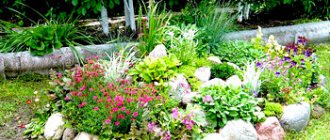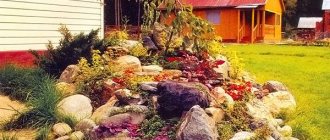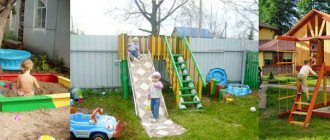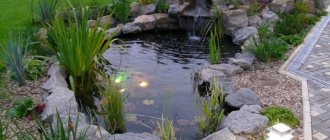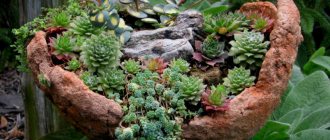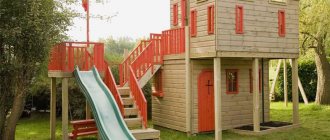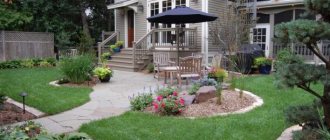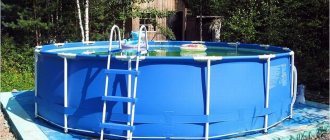An alpine slide is usually called an artificially created composition of boulders of various rocks of different sizes. This composition should imitate a multi-level mountainous terrain, complemented by plants, most often conifers and evergreens. The rock garden today is one of the most popular tools that professional landscape designers use in their work. You can build an alpine slide on your site with conifers yourself, and right now you will learn how to do this, but first things first.
Alpine hill with conifers: types
There are several types of alpine slides, all of them visually have intricate and bizarre shapes and different sizes, which allows you to choose the optimal option for the area and terrain that is available. Among the easiest types of slides to implement on your own are:
- A mountain slope can be created on a site on the territory of which an unfilled trench or foundation pit remains. The base of the slope is laid out with small boulders, while the slope itself is formed by larger stones.
- Terraces or Steps , the horizontal surface of which can be organized using medium-sized boulders.
- The plateau is a flat surface on which stones of different types, sizes and colors are located.
- A cliff or rock perfectly masks and strengthens soil protrusions in the area. This type of rock garden goes well with all of the above options.
- The Gorge is the exact opposite of the Cliff or the Rock. When creating this option, it is necessary to use available masonry material to secure the stones and boulders, otherwise collapse may occur.
In addition, types of alpine slides are divided into large and small. For large ones, massive boulders are used; for creating small ones, granite and limestone crushed stone of large fractions are suitable.
With a pond and a waterfall
To build an alpine slide, complicated by the design of a reservoir or waterfall, you need to familiarize yourself with the stages of their design and arrangement. To make them yourself, you need to understand the general scheme and order of work.
Construction is divided into stages:
- The place under the pond is pre-marked using driven pegs and rope. Next, a pit of the required depth is dug.
- The shape of a garden pond must be installed in the hole, then the overall level is checked. The resulting container is slowly filled with water. The surrounding area must be covered with sand, while simultaneously watering it with water. It is necessary to compact it along with filling all the resulting voids. For convenient watering, you can connect a hose.
- A slide is poured out of sand, stones are laid with a slight slope back, but parallelism should be visually indicated. For the embankment to be natural, all lines must diverge smoothly. If the site has a slope, then there is no need to make an embankment, and it is better to place the reservoir at the end of the slope. If the place is chosen to be absolutely flat, then the slide is strengthened with a retaining wall made of brick or stone. At the same stage of construction, a cascade is made; it is needed for a waterfall. To do this, you can purchase a ready-made structure, but it is possible to place flat stones at a given height.
- The pond must have a pump that must be placed completely under water. The hose goes through the ground, so it needs to be dug down a little; it is well camouflaged by plants and stones.
- A layer of fertile soil must be built on the alpine hill. It is made from compost, sand, crushed stone and sawdust mixed with soil.
- Plants can be planted both on the shore, on an alpine hill, and inside a reservoir.
https://youtu.be/ziHJh06T1Vs
Dry stream. Read about it here. And here is an article about wooden pergolas.
See our website. And you will learn a lot more informative, useful information.
Conifers for an alpine hill: what is better to choose
A coniferous hill looks much more impressive if there are several types of plants in the composition. To create landscape compositions in central Russia, as a rule, the following is used:
- Thuja of various varieties . Most often, among others, experts choose light spherical Danica, cone-shaped Filiformis and yellow Golden Globe. These plants have a dense crown, perfect for shaping into various shapes and figures by trimming with ordinary garden pruning shears. Thuja propagates by cuttings; it is better to buy it as seedlings in a nursery.
- Cypress trees are great for gardening, including for creating hedges. When choosing a plant for mid-latitudes, it is better to give preference to the Lawson and Gorokhoplodnik varieties, since they tolerate frost better than others.
- Spruce is a resident of our latitudes; the Russian winter is not scary for it. A composition with conifers will be an excellent place to “reside” for dwarf spruce trees. When choosing dwarf spruce trees, we pay attention to the Albert Glob and Nidiformis species.
- Pine spruce , takes root well and feels great in northern latitudes. A hill of coniferous plants with emerald needles of the dwarf pine variety Cobold or Watereri can become a real decoration not only for a summer cottage, but also for a personal plot. For a small garden and miniature rock garden, you can buy a dwarf pine Globosa Viridis, which does not grow more than one meter in height.
- Frost-hardy juniper is another ideal choice. Moreover, you can use any variety of this plant.
Traditional annual flowers that bloom all summer, with photo and name
There are flowering annuals that are traditionally used to decorate city parks and squares, country houses and summer cottages. They are known to everyone since childhood. Such flowers are simple and unpretentious, but without them it is difficult to imagine at least one landscape solution.
Below is a brief description of traditional annual flowers for the garden that bloom all summer, with photos and names.
Marigold
Annual flowers Marigolds
Very cute and bright. Large varietal range with different bush heights, size and color of flowers. The colors of the buds are always warm: from pale yellow to red-brown. They come in simple and terry shapes. The bushes are densely branched, compact and stable. For borders, varieties that grow up to 20 cm are used, and for flower beds - up to 60 cm. Marigolds are hardy, cold-resistant, easily tolerate drought and poor soil, but do not like shade and dampness. It is better to grow through seedlings, then flowering begins at the end of May. They emit a not very pleasant smell, but this feature of the flower repels pests, including white butterflies, cutworms, weevils, Colorado potato beetles, etc.
Calendula
Annual flowers Calendula
In common parlance - marigolds. The stem is erect, fragile, up to 50 cm tall, with ovate leaves and many inflorescences - baskets. Flowers with orange and yellow petals of simple shape. It blooms from early June until the snow, and easily tolerates five-degree frosts. Loves bright sun. It is the most valuable medicinal raw material.
Petunia
Annual flowers Petunia
Low-growing (up to 30 cm) or tall (up to 70 cm) annual plant with a shallow root system, densely branched stems, which can be either creeping or erect, depending on the variety. For the same reason, the leaves vary in shape and shades of green. They have a faint edge. The flowers are solitary, funnel-shaped, with an upper extension and a surprisingly varied color and structure of the petals. The plant is thermophilic, prefers well-lit flower beds, blooms constantly, and is grown as seedlings.
Snapdragon
Annual flowers Snapdragon
In common parlance - dogs. It is harmonious in any landscape combination, often used as a border planting, and hanging varieties are ideal for flowerpots. Perennial, but in the Russian climate it can only live for one season. The seeds are well stored. Seedlings (sown in February-March) develop slowly at first; after the 5th leaf appears, the main shoot is pinched so that the plant bushes. Planted in a flowerbed at the end of May in a sunny and dry place. Blooms all season until October, unpretentious. It grows up to 45 cm, has original two-lipped flowers of various colors.
Viola or Pansy
Annual flowers Pansy
Common garden annuals. Nowadays, monocolor varieties are especially popular, which are great for contrasting solutions. Low-growing, reaching a maximum height of 25 cm. The flowers are single (up to 10 cm in diameter) with a wide range of colors; some varieties have a subtle, pleasant aroma. Seeds are planted directly into the ground at the end of May. For early flowering, you can sow seedlings in March. They can easily tolerate a little shade. The soil should be fertile, watered regularly, but without stagnation of moisture. Loves fertilizers, especially with phosphorus to improve flowering.
Climbing annual flowers for the garden
There is a special type of annuals that are a salvation when decorating garden buildings, be it fences, walls of buildings or gazebos, arches and hedges. We are talking about climbing annual flowers for the garden. The use of this group of annuals in landscape design is mandatory and justified.
Lianas will protect an area located next to a busy highway from dust and noise, decorate an unsightly façade, and serve as a screen or hedge. When choosing a loach variety, you should think about what kind of support it should have. There are quite heavy, densely growing vines that will require an impressive supporting structure.
It is necessary to think in advance about the place where the climbing plant will grow:
- the south and southeast are perfect for ampelous gloxinia, sweet peas, cornflower and morning glory;
- the eastern part of the site is ideal for kobei and dolichos;
- the shaded northern and northwestern sides are for ivy and maiden vine.
How to make an alpine slide from conifers with your own hands: a guide
In the process of creating a landscape composition in your garden, you must first choose a location and create a drainage system.
Features of choosing a place
When choosing a location for an alpine slide, it is highly advisable to find an open space that will be exposed to direct sunlight throughout the day. An excellent choice is the southern or southwestern part of the site. Depending on your preferences, this place can be private, where it is convenient to relax, meditate and be alone with yourself. Or maximally viewed, to the envy of the neighbors.
Selecting a location
Before you make an alpine slide, you need to decide on its location. It should be sunny, with natural relief, without bright flower beds and outbuildings.
It would be nice if there was a water source nearby. A recreation area or gazebo is placed nearby so that there is an opportunity to admire the “creation of human hands.”
Rules for caring for the composition
- At the beginning of spring, you need to remove all covering material from the rock garden, remove broken branches, add fresh soil, plant annual flowers, apply fertilizer, mulch and water.
- In summer, plants need to be regularly watered and sprayed, weeds removed, crowns formed, and treated with insecticides and slug repellents.
- In the fall, it is necessary to remove all annual plants, renew the mulch, fertilize the soil, cover everything with film or spruce branches, which can be laid on top of geotextiles.
- In winter, in severe frosts, you can cover the alpine slide with snow and make sure that the covering material remains in place.
Perennials for the hill
The rock garden is not created forever, and annual adjustments, of course, are made. However, by planting a hill with perennial plants that bloom beautifully and do not require special attention, we make it easier to care for the plantings.
When choosing and considering perennial flowers for an alpine hill, photos, their names may not coincide with folk ones, or those that are popular in your area, so it is better to use botanical nomenclature.
Perennials blooming in spring
The flowering of bulbous plants is picked up by perennials. Blooming in the spring, they cover the slopes with their graceful flowers, and then their decorative foliage will serve as a background for those blooming in summer and autumn.
Tenacious (ayuga)
This plant is not very showy in flower, but its colorful foliage spreads out like a mat and creates a velvet effect.
The plant can be planted both in spring and autumn, it is not picky about the conditions, and is suitable for growing on the north side of the rock garden.
Arabis (rezucha)
The plant will create a huge white carpet. It is unpretentious, not demanding and blooms on both the southern and northern sides of the hill.
Arabis quickly takes over territory, but after flowering it is enough to prune it to maintain both its compactness and neat appearance.
The dark green foliage that remains after flowering does not lose its decorative value throughout the year. If your region has snowless winters, then this plant will be a true decoration of the hill in the autumn-winter period.
The plant reproduces well by shoots of rhizomes. It grows quickly and does not require soil or care.
Corydalis
This plant will delight you in early spring with beautiful carved foliage and blue flowers, and then completely disappear from sight. However, its existence must not be forgotten. Next spring it will sprout again and again create a blue carpet.
Propagated by planting rhizomes during any period of vegetation or dormancy. The plant is unpretentious and very attractive.
Iberis
A perennial plant that blooms profusely and for a long time with white small flowers, which are collected in inflorescences.
After flowering, the plant is pruned, and cuttings can be cut immediately for planting in a greenhouse.
The plant is unpretentious, blooms in partial shade no worse than in open space.
Original ideas for alpine slides made of stones and conifers
Today, the creation of alpine slides is being done all over the world, and Asians have achieved particular success in this matter. In almost every Chinese, Korean, Japanese public park and public garden you can find stunningly beautiful rock gardens. Of course, you can borrow some original and creative ideas for your garden.
- The stone garden under the window - you can admire it every day.
- A multi-colored composition, using to create it plants with a certain color of leaves and flowers, for example, purple, semolina, lavender and viola, thanks to which you can get a yellow-violet composition.
- The monochrome rock garden is, of course, green.
- A rock garden and a stream imitating a mountain river with waterfalls.
- A rock garden, that is, a rock garden in which there will be a minimum number of plants, or there will be none at all.
- A practical garden that can be used in the form of a staircase.
- A camouflage slide that will hide any defect in the wall, facade, or basement of your house.
- A useful rock garden that uses not ornamental, but fruit, berry and fruit trees and shrubs.
- Miniature, which can be placed on the veranda or terrace of the house, or even on the loggia.
- Rock garden with multi-colored stones.
Perhaps this is all you should know about before you start creating an alpine slide in your garden, dacha, or personal plot.
Which plants are suitable
Plants for an alpine hill are selected carefully: it is necessary to take into account their combination, flowering period, growth characteristics, and climatic conditions of the region. For example, in order for a rock garden to please the eye for a long time, select plants with alternate flowering.
Some perennials are aggressive towards other flowers - this should also be taken into account when planting.
How to plant juniper along a path
The paths framed by greenery look beautiful . Moreover, it is not necessary to plant bushes densely along them. It is enough to place several specimens of juniper, and at the corners, if the path turns, collect compositions from boulders.
When planting plants, you must follow these rules:
- Move trees 150 cm away from the path, as they can easily disrupt its geometry, and their crown will interfere with movement.
- Leave a distance of about one meter between bushes.
- It is advisable to arrange all plants in ascending order - from south to north. Then they will not cast a shadow on the “neighbor”.
- Create a composition in which each element complements the other.
In the described location, the landing process is carried out as follows:
- Release the roots from the container or bag.
- Place in the planting hole, straighten the rhizome.
- Sprinkle with soil and compact so that there are no voids left.
- Water generously.
Find out also about the use of spruce in landscape design.
Alpine slide with juniper
Rock gardens are now quite a popular element of landscape design due to their naturalness. The place for it is selected taking into account the light preferences of the plants from which it will be composed. Ideally, this is a northwestern or northern slope.
Planting juniper in rock gardens is carried out in early spring or early autumn. It is better to use seedlings with a closed root system. There should be 50–100 cm between neighboring plants. The depth of the holes depends on the condition of the soil and the variety of juniper, but usually it is about 0.7 m. The further process is similar to those described above.
